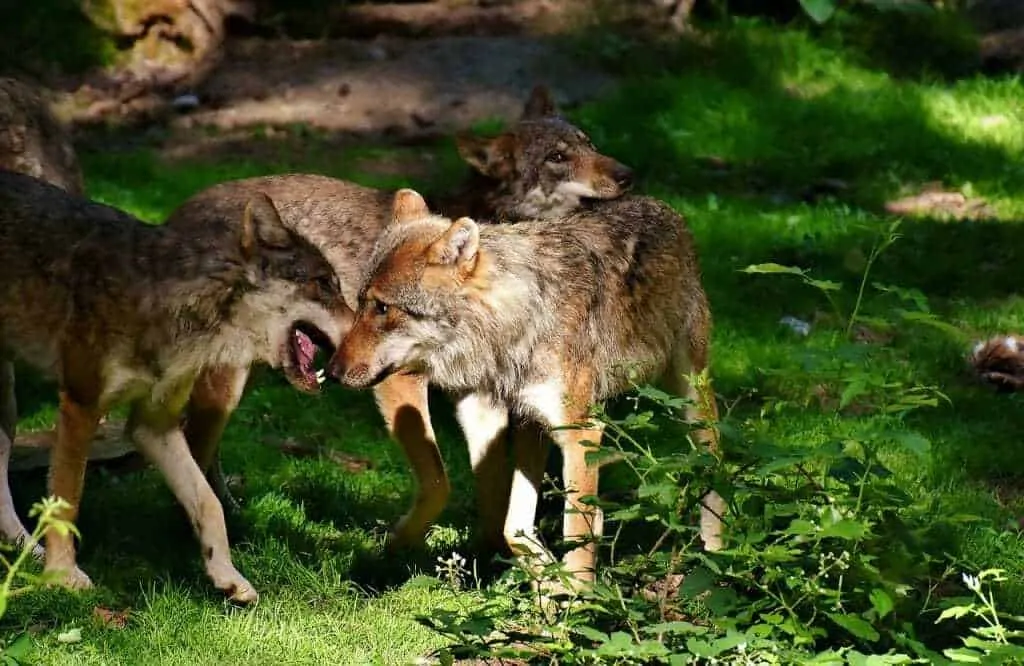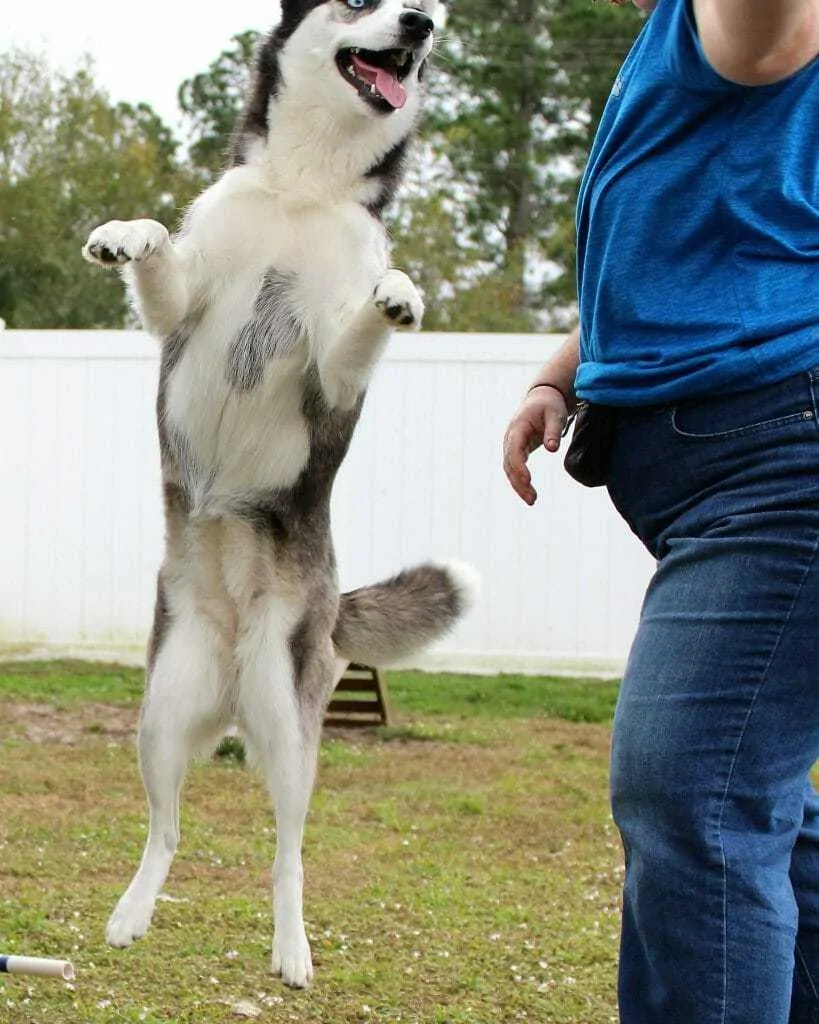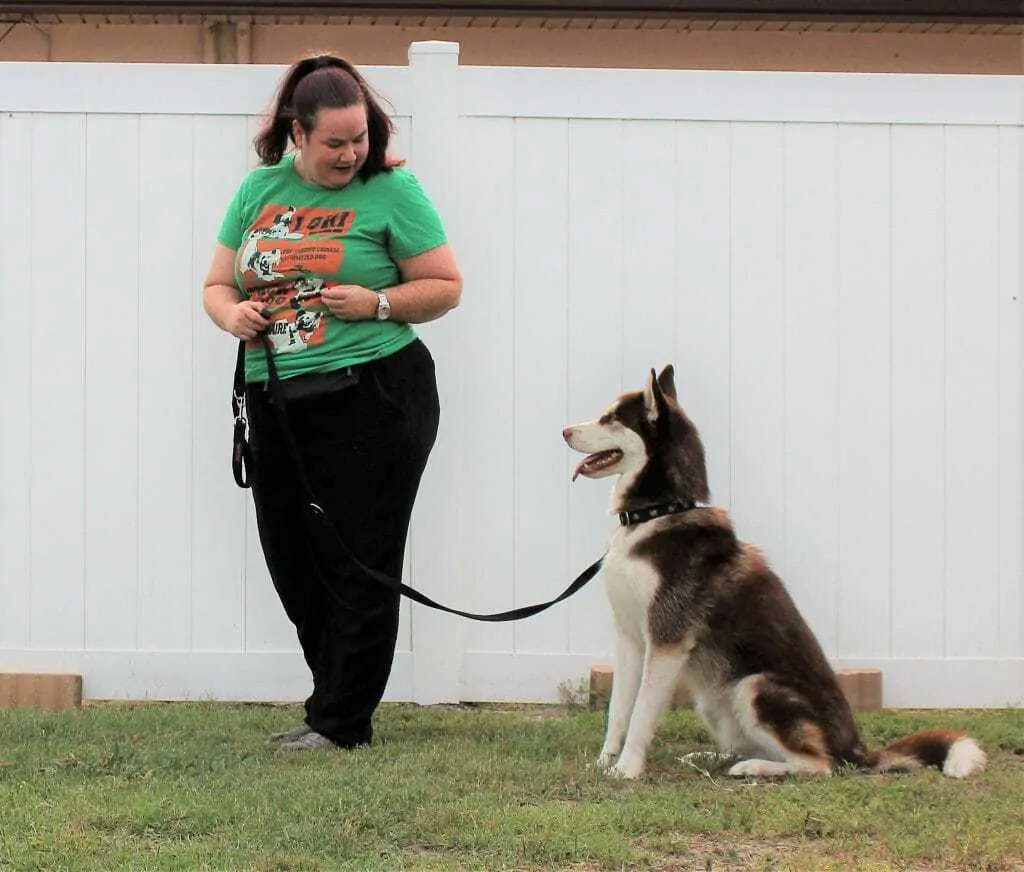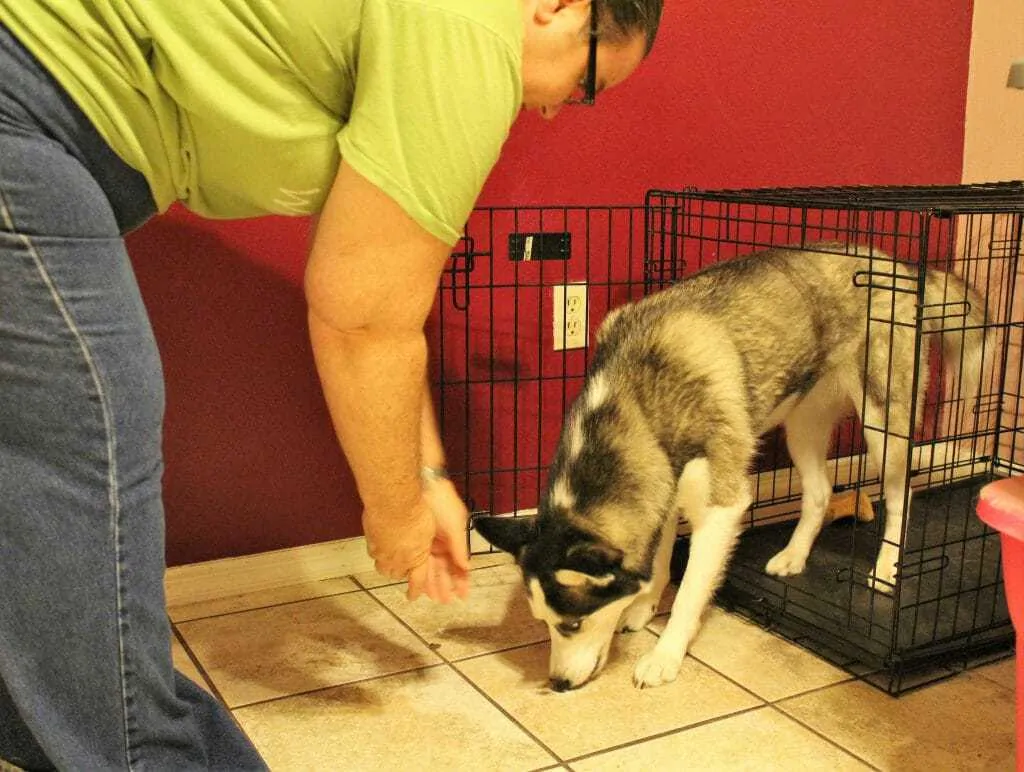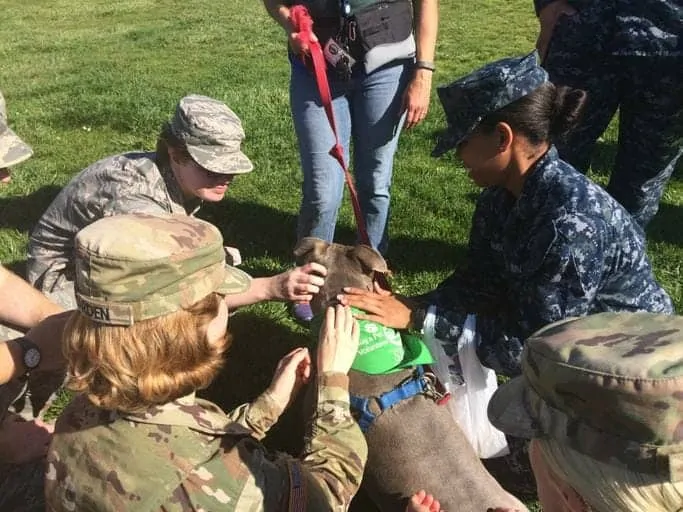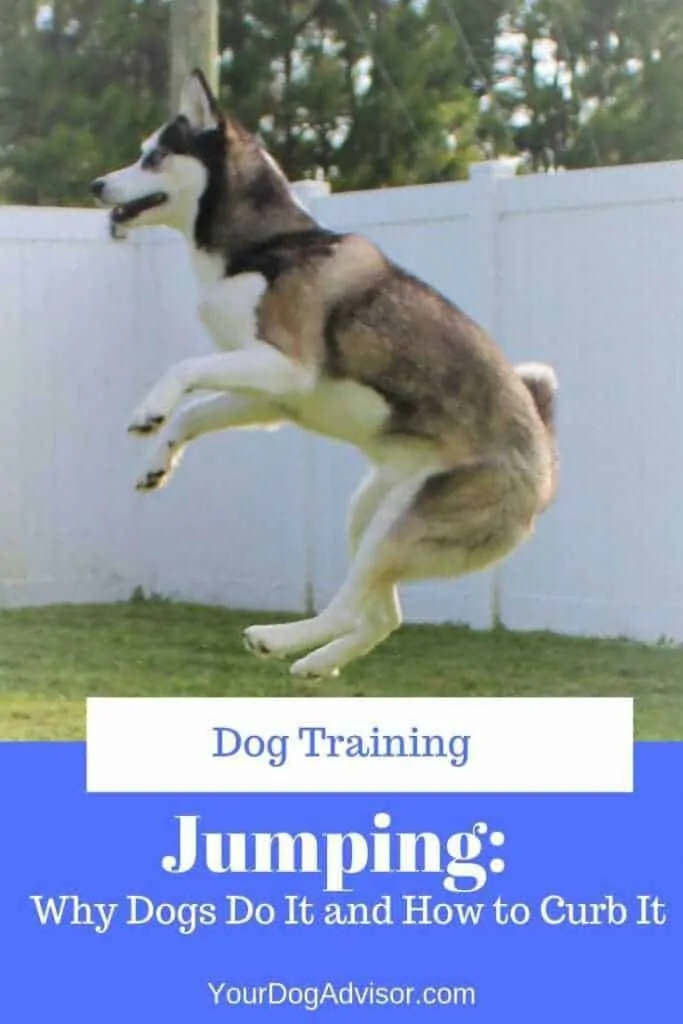Excessive jumping. No dog is immune to it. Whether you have a big dog or a small dog, it is one of the most common bad habits us trainers get asked to “fix”, one of the hardest habits to keep from being reinforced and in the end, the most important fact to remember about jumping is that, for a dog, it is completely normal canine behavior. Simply put, it is one of the habits that makes a dog a dog. So if you want to change the normal behavior of another animal, it is going to take some work. Only by actively teaching your dog alternative behaviors will you be able to conquer this problem.
Contents
Why Do Dogs Jump?
If you are working with your dog on a jumping issue, it helps to understand the reasons why dogs jump.
-
Natural Instinct
For many canids, both wild and domestic, it is normal practice for the mother dog to eat and regurgitate her food for puppies, as shown in this study. The puppies learn to jump at the mother’s mouth to get the food. This instinctual behavior transfers over to you, when you become the pups new caretaker.
Wolves regurgitate their food for their pups.This adolescent wolf still mouths his mom, even though he is well past the weaning of this behavior. Many domesticated dogs also exhibit these same behaviors of their distant, wild relatives.
-
Greeting Ritual
Dogs interact with each other much differently than us and rely mainly on body language and signals to communicate with each other. From an early age, it is an acceptable greeting for puppies to jump on one another to say hi and initiate play. They also are used to greeting each other at eye level so they can read facial expressions, including direct eye contact. So essentially, they are only trying to communicate with us the only way they know how, and for them, we are just too tall!
This Pug is jumping just because he wants to be eye level and read his owner’s facial expressions.
-
Release of Excess Energy
If a dog has not had enough physical exercise, many different behaviors can present, including but not limited to jumping, to release this excess energy. You might often times see these behaviors when your dog gets the zoomies.
-
Excitement and Hyper-Arousal
In the end, the simplest of reasons, is that dogs jump just to show their excitement and exuberance about something, so the take-away here is that yes, in fact, your dog is happy to see you!
You can’t get any more exuberant than this young husky!
What NOT to Do
So now that we know why our dogs jump, and that it is completely normal, learned and even reinforced behavior from pretty much birth, what do we do to take something that is so second nature and turn it into something different or new? To be efficient in this initial step of training, we first need to know what NOT to do and what behaviors we ourselves need to stay away from. In your dog’s mind, any attention, be it negative or positive, is still attention. Since many times the act of jumping is initiated solely to elicit attention, it is important to remember not to spend time correcting your dog, but rather being proactive and redirecting your dog to behaviors you would prefer him to do instead.
-
Don’t Raise Your Voice
Whether your dog startles you by the act of jumping or you are just blowing off some steam, a dog that is excited or hyper-aroused is going to get more supercharged by your vocalizations. In their world, dogs bark, growl, yip and do many other types of vocalizations when engaging in play. Your heightened tone will only fuel an excitable dog. Instead, deal with this behavior in calm, neutral tones or avoid any verbal communication completely.
-
Do Not Physically Handle Your Dog In Any Way
Of course, any scientifically educated trainer or behaviorist will tell you that you should never use physical punishment when training your dog. This would include tactics such as kneeing a dog, leash yanking, etc. However, often times we use physical handling in jumping situations without even realizing, a.) that we are doing it at all and b.) that doing so can actually reward the behavior. For instance, it might be our natural reaction to simply push a dog away with our hands, but that physical connection could be rewarding to your dog, who really is craving physical contact with you at this point. Instead, resist the urge to push them off and simply turn your back, pull your arms in and deny any attention until their feet are back on the ground.
Instead of trying to push your dog away, step away, turn your back and pull your arms in to you.
Steps to Take to Stop Excessive Jumping
The most important thing to remember when you are dealing with any bad habit, is to be proactive in your training plans. In this case, this means, don’t wait until the jump is already happening and then react, rather you should put training scenarios in place in easier situations first so your dog is set up to succeed and then increase your criteria to those harder situations once your dog understands what is expected of him.
Here are a few simple steps you can take to get your pup well on its way to better behavior around you, guests and people you might meet on your outings.
Step #1: Exercise Your Pet Before Training Sessions
Since energy level has a lot to do with this habit, it is always a good idea to exercise your dog before practice sessions or simulations where you might incorporate other people. A nice game of fetch, a brisk walk or jog or some practice of your recalls can go a long way to get you started off on the right foot.
Getting involved in agility training is another great way to exercise your dog.
Step #2: Work On Games to Help Your Dog With Impulse Control
Your dog is having a hard time controlling his actions when he is excited. Working on a variety of impulse control games every day can help your dog learn better self control in a variety of situations. Impulse control games teach your dog how to take your dog from a high state of arousal to a low one, quickly and for longer periods of time so your dog can learn how to settle himself. There are many different types of impulse control games. Here are a couple ideas to get you started:
The Elevator Game
The Elevator Game is great for teaching impulse control if your dog is jumpy when you put their food bowl down. (self-taken)
The Quick Settle Game
This game will help your dog learn how to settle down a little quicker when they are excited. As you practice you can increase the amount of time your dog must settle for. (self-taken)
To learn more about impulse control tricks and games, check out the book “Hyper Dog 101”. It is chocked full of useful info to help you with your bouncy dog.
No products found.
Step #3: Control the Environment
Remember, it is your job to set your dog up for success, so before and during practice sessions make sure you are prepared to help your dog make the right decision before a jump even occurs. A few things that you will want to consider when managing your dog’s environment are:
-
Put Your Dog On Leash
It is a lot easier to help your dog away from a jumping situation when you have a leash on, so if your dog is excessively jumping on your guests as they enter the front door, be sure to put that line on before anybody approaches your dog.
Make sure you have a leash on and your dog can focus on you before greeting people.
-
Carry High-Value Rewards
Invest in a handy treat pouch and carry some delicious morsels on you. You want to be ready to reward your dog every time he makes the right decision instead of jumping. This could be rapid-fire reward sessions when you first start, so be prepared with some high-value training treats.
-
Intervene Petting If Need Be
Remember, any physical touch could be rewarding the jump. We all have that friend or neighbor that says something to the effect of, “Oh, it’s OK, my dog jumps too!”, but in these situations it is important to intervene before the dog gets reinforced for jumping. Don’t be afraid to position your body in between your dog and the person and get your dog under control before any petting happens. You can do this by offering your dog one of those tasty treats and requesting a position, such as a Sit. If your dog is acting too wild and can not control himself and focus on you, politely excuse yourselves. I say something like, “I’m sorry, he’s a little too wound tight right now” and deny any petting. In future practice sessions, go back a step or two and decrease your criteria so the situation or environment is a little easier.
Step #4: Reward Low During Greetings
This picture demonstrates me feeding Nova on the floor as she is released from her crate, so she learns to look down, instead of jumping up as soon as she comes out.
Since your dog is only trying to greet you face-to-face, it is a good idea to redirect your dog’s attention to looking at the floor for rewards when you are coming in the front door or a new person approaches.
- Practice walking around a room/area and dropping treats by you on the floor before your dog catches up with you and tries to jump (it’s all about being proactive!) If you are late in your delivery and your dog jumps on you, simply move away and ignore the behavior. I find a clicker to be very helpful in marking my timing with practices such as these. We are teaching the dog that we want them to come towards us and keep all 4 paws on the floor.
- When your dog tries to jump and you ignore the behavior, look for other good behaviors your dog might offer, instead of the jump (such as a Sit or Down) and Mark and Reward those behaviors.
- Once your dog is consistently offering four paws on the floor during practices, set your dog up in more difficult scenarios as you continue. Try rewarding low like this when you do things like let them out of their crate after a long day or when you first walk in the front door.
Step #5: A Bomb-Proof Sit
A lot of people teach their dog to Sit, but to help with a jumping behavior, this basic skill needs to be bomb-proofed, meaning they can sit during all kinds of difficult distractions, including even, people that want to pet them!
This dog’s Sit is being proofed with lots of distractions. Even though he is doing a great job, the handler is still managing her dog’s environment by keeping him on leash and she is equipped with her treat bag of delicious treats to reward all positive behaviors.
To do this, you must slowly increase the difficulty level of your dog’s Sit by identifying hidden triggers that might cause your dog to jump and desensitizing him to those movements.
Here are a few examples of body movements from people that might trigger a jumping habit:
- Bending over
- Crouching down
- Pets on top of the head
- Waving hands up high
- Quickly pulling hands away (such as a person who is avoiding getting clobbered by your dog)
Once you have identified these triggers, practice them by pairing them with your Sit. For instance, if my dog jumps at people every time they bend over to go in for a pet, I am going to do some rapid-fire practices where I begin to ask my dog to Sit with their visual and verbal cue as I add in the visual trigger of bending over. By pairing these together, and rewarding the Sit, I can actually start weaning off my dog’s hand signal and the bending over can start becoming a new body language cue for the Sit, instead of a trigger for jumping up.
This video demonstrates how you can use cue transfer to help with your dog’s jumping habit.
Once you feel confident proofing your dog’s Sit in many different locations, distractions and with a variety of different body movement triggers, enlist the help of family, friends or neighbors, to take it to the next level!
Your dog’s success in not becoming an excessive jumper begins with you. To change any instinctive behavior in an animal, it takes practice and an almost ritualistic approach to the consistency of your redirection, to help your dog do the right thing. By learning how to be proactive instead of reactive and following these steps, you will be well on your way to a well-behaved dog that knows when four paws need to be on the floor.
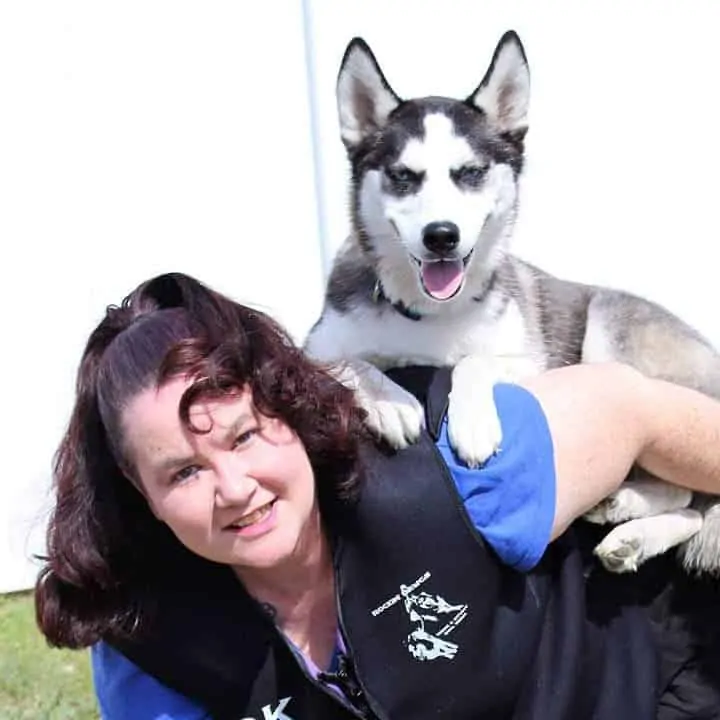
Kim Mayes has been training, performing and competing with her dogs for over 20 years. She is a Certified Professional Dog Trainer (CPDT-KA) a Certified Trick Dog Instructor (CTDI) and Stunt Dog Judge (SDJ) amongst her many certifications. She is a published author in the area of training and behavior, writing books such as “Getting Braver” and “Hyper Dog 101” and owns Rockin’ Dawgs Positive Dog Training LLC in Rockledge, FL. She is also a proud member of the Pet Professional Guild which promotes the importance of using force-free training.
Kim resides in Brevard County, Florida with her 3 Siberian Huskies, Seppala, Rocket and SuperNova, and her Chinese Crested Dog, Loki. Her wonderful rescue pack has gone on to achieve Champion titles and even hold world records in the trick and stunt world.
